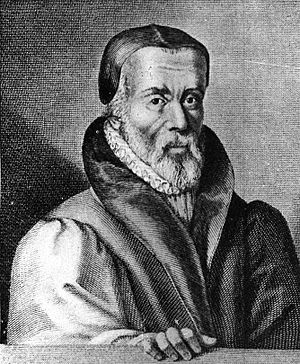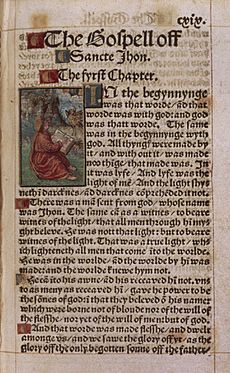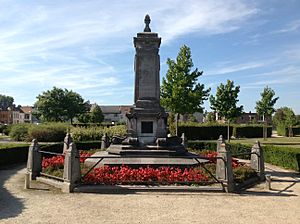William Tyndale facts for kids
Quick facts for kids
William Tyndale
|
|
|---|---|
 |
|
| Born | c. 1494 |
| Died | c. (aged 42) |
| Nationality | English |
| Alma mater | Magdalen Hall, Oxford University of Cambridge |
| Known for | Tyndale Bible |
William Tyndale (born around 1494 – died around 6 October 1536) was an important English scholar and language expert. He became a key leader in the Protestant Reformation before he was executed.
Tyndale is famous for translating the Bible into English. He was inspired by other Protestant leaders like Martin Luther. Luther's German Bible translation came out in 1522. Tyndale's translation was special because it was the first English Bible to use the original Hebrew and Greek texts. It was also the first English translation to use the new printing press technology. This helped spread his ideas quickly.
His Bible was a direct challenge to the power of the Catholic Church and the laws in England that supported it. Tyndale's work helped spread Reformation ideas across the English-speaking world.
Later English Bibles, like the Great Bible and the Bishops' Bible, used Tyndale's translation. Even the famous King James Version (published in 1611) used a lot of Tyndale's original work. Some experts believe that about 83% of the New Testament and 76% of the Old Testament in the King James Version come from Tyndale's words.
Tyndale also wrote a book called The Obedience of a Christian Man (1528). This book suggested that the king should control the church in his country, not the Pope. King Henry VIII read this book. It helped him decide to separate the Church in England from the Catholic Church in 1534. In 1530, Tyndale wrote The Practice of Prelates. In this book, he disagreed with King Henry's plan to end his marriage to Catherine of Aragon. Tyndale believed it went against the Bible.
Because of his work, Tyndale had to leave England. He found safety in the Flemish area, which was part of the Catholic Charles V, Holy Roman Emperor's lands. In 1535, Tyndale was arrested and put in jail in the castle of Vilvoorde near Brussels. He was held there for over a year. In 1536, he was found guilty of heresy (having beliefs that went against the official church teachings) and was executed.
In 2002, Tyndale was voted 26th in a BBC poll of the 100 Greatest Britons.
Contents
Early Life and Education
Tyndale was born around 1494 in a village called Stinchcombe in Gloucestershire, England. His family was also known by the name Hychyns. William Tyndale used this name when he started at Magdalen Hall, Oxford. His family had moved to Gloucestershire in the 1400s.
Tyndale began studying at Oxford University in 1506. He earned his first degree in 1512. He was known as a good and honest person. After his first degree, he could study theology (the study of religious faith). However, the official courses did not include a deep study of the Bible itself.
Tyndale was very good with languages. Over the years, he learned to speak French, Greek, Hebrew, German, Italian, Latin, and Spanish, in addition to English. Between 1517 and 1521, he also studied at the University of Cambridge.
After his studies, around 1521, Tyndale became a chaplain and tutor for the children of Sir John Walsh in Gloucestershire. His ideas were not popular with other church leaders. In 1522, he was called to appear before John Bell, a church official. No formal charges were made at that time.
After this meeting, Tyndale had an argument with a clergyman. The clergyman said, "We had better be without God's laws than the Pope's." Tyndale famously replied, "I defy the Pope and all his laws. If God spares my life, in a few years, I will make sure that a boy who drives a plow will know more about the Bible than you do!"
A Big Idea: Translating the Bible
In 1523, Tyndale went to London. He wanted to get permission to translate the Bible into English. He asked Bishop Cuthbert Tunstall for help. Bishop Tunstall was a famous scholar, but he refused to support Tyndale.
Tyndale stayed in London for some time, studying and preaching. He got help from a cloth merchant named Humphrey Monmouth. During this time, he gave many talks, including at St Dunstan-in-the-West Church.

In the spring of 1524, Tyndale left England for Europe. He may have gone to Hamburg and then to Wittenberg. He started translating the New Testament around this time. He finished it in 1525 with help from William Roy.
In 1525, the printing of his New Testament in Cologne was stopped. This was because of strong opposition to Lutheranism. A full edition of the New Testament was finally printed in 1526 in Worms. Worms was a city that was starting to accept Lutheran ideas. More copies were soon printed in Antwerp.
Tyndale's Bibles were secretly brought into England and Scotland. In October 1526, Bishop Tunstall officially spoke out against the translation. He warned booksellers and had copies of the Bible burned in public. This act of burning the Bible caused a lot of debate, even among religious people. Cardinal Wolsey declared Tyndale a heretic in 1529.
Tyndale stayed in Worms for about a year. It is not clear exactly when he moved to Antwerp. He continued to work in secret. He revised his New Testament and started translating the Old Testament.
His Arrest and Final Days
In 1530, Tyndale wrote The Practice of Prelates. In this book, he spoke against King Henry VIII's desire to end his marriage to Catherine of Aragon. He believed it was wrong and a plot by Cardinal Wolsey. King Henry was very angry with Tyndale. He asked Emperor Charles V to arrest Tyndale and send him back to England. However, the emperor said he needed formal proof before doing so.
Eventually, Tyndale was betrayed by a man named Henry Phillips. He was arrested in Antwerp in 1535. He was held in the castle of Vilvoorde near Brussels. Some people think Phillips was hired by Bishop Stokesley to trick Tyndale and then betray him.
Tyndale was put on trial for heresy in 1536. He was found guilty and sentenced to death. Even though Thomas Cromwell tried to help him, Tyndale was executed. His last words were reportedly, "Lord! Open the King of England's eyes." He is traditionally remembered on October 6th.
Within four years of Tyndale's death, four English Bible translations were published in England. The king himself ordered these translations. All of them were based on Tyndale's original work.
Tyndale's Lasting Impact
Tyndale's work had a huge impact on the English language and on future Bible translations.
New Words and Phrases
When Tyndale translated the Bible, he introduced many new words into the English language. Many of these words were later used in the King James Bible. Some examples include:
- Passover (for the Jewish holiday)
- scapegoat
- atonement (meaning to make "at one" or reconcile)
- mercy seat
Tyndale also created many common English phrases that we still use today:
- my brother's keeper
- knock and it shall be opened unto you
- a moment in time
- seek and ye shall find
- ask and it shall be given you
- judge not that ye be not judged
- let there be light
- the powers that be
- the salt of the earth
- it came to pass
- the spirit is willing, but the flesh is weak
Shaping Future Bibles
Tyndale's translation was very important for all later English Bibles. The translators of the Revised Standard Version in the 1940s said that Tyndale's work inspired many translations. These included the Great Bible (1539), the Geneva Bible (1560), the Bishops' Bible (1568), and the King James Version (1611). They noted that the King James Version "owed most, especially in the New Testament, to Tyndale."
One study in 1998 showed that Tyndale's words make up 84% of the King James New Testament. They also make up 75.8% of the Old Testament books he translated. Many English Bible versions since then have been inspired by Tyndale. This includes the Revised Standard Version and the English Standard Version. Even modern paraphrases like the Living Bible share Tyndale's goal of making the Bible easy to understand for everyone.
Printed Works
Tyndale is best known for his Bible translation. However, he also wrote and translated other important works. He focused on how religion should be lived and also on political issues.
| Year Printed | Name of Work | Place of Publication | Publisher |
|---|---|---|---|
| 1525 | The New Testament translation (incomplete) | Cologne | |
| 1526* | The New Testament translation (first full printed edition in English) | Worms | Peter Schöffer the Younger |
| 1526 | A compendious introduction, prologue, or preface into the epistle of Paul to the Romans | ||
| 1527 | The parable of the wicked mammon | Antwerp | |
| 1528 | The Obedience of a Christen Man (and how Christen rulers ought to govern...) | Antwerp | Merten de Keyser |
| 1530* | The five books of Moses [the Pentateuch] translation (each book with individual title page) | Antwerp | Merten de Keyser |
| 1530 | The practice of prelates | Antwerp | Merten de Keyser |
| 1531 | The exposition of the first epistle of Saint John with a prologue before it | Antwerp | Merten de Keyser |
| 1531? | The prophet Jonah translation | Antwerp | Merten de Keyser |
| 1531 | An answer to Sir Thomas More's dialogue | ||
| 1533? | An exposition upon the. v. vi. vii. chapters of Mathew | ||
| 1533 | Erasmus: Enchiridion militis Christiani translation | ||
| 1533 | The Souper of the Lorde | Nornburg | Niclas Twonson |
| 1534 | The New Testament translation (thoroughly revised, with a second foreword against George Joye's unauthorized changes in an edition of Tyndale's New Testament published earlier in the same year) | Antwerp | Merten de Keyser |
| 1535 | The testament of master Wylliam Tracie esquire, expounded both by W. Tindall and J. Frith | ||
| 1536? | A pathway into the holy scripture | ||
| 1537 | The Matthew Bible, which is a Holy Scripture translation (Tyndale, Rogers, and Coverdale) | Hamburg | Richard Grafton |
| 1548? | A brief declaration of the sacraments | ||
| 1573 | The whole works of W. Tyndall, John Frith, and Doct. Barnes, edited by John Foxe | ||
| 1848* | Doctrinal Treatises and Introductions to Different Portions of the Holy Scriptures, edited by Henry Walter. | Tindal, Frith, Barnes | |
| 1849* | Expositions and Notes on Sundry Portions of the Holy Scriptures Together with the Practice of Prelates, edited by Henry Walter. | ||
| 1850* | An Answer to Sir Thomas More's Dialogue, The Supper of the Lord after the True Meaning of John VI. and I Cor. XI., and William Tracy's Testament Expounded, edited by Henry Walter. | ||
| 1964* | The Work of William Tyndale | ||
| 1989** | Tyndale's New Testament | ||
| 1992** | Tyndale's Old Testament | ||
| Forthcoming | The Independent Works of William Tyndale | ||
| Forthcoming | Tyndale's Bible - The Matthew Bible: Modern Spelling Edition | ||
|
*These works were printed more than once, usually signifying a revision or reprint. However, the 1525 edition was printed as an incomplete quarto and was then reprinted in 1526 as a complete octavo. **These works were reprints of Tyndale's earlier translations revised for modern spelling. |
|||
Remembering Tyndale Today
Many memorials and institutions honor William Tyndale's life and work.
Statues and Monuments
A memorial to Tyndale stands in Vilvoorde, Flanders, where he was executed. It was built in 1913. There is also a small William Tyndale Museum in the town.
A bronze statue of Tyndale was put up in Victoria Embankment Gardens in London in 1884. It shows him with his hand on an open Bible, which rests on an early printing press. Another life-sized bronze statue of Tyndale was placed in Millennium Square, Bristol, in 2000.
The Tyndale Monument was built in 1866 on a hill above his supposed birthplace in Gloucestershire.
Schools and Organizations
Several colleges, schools, and study centers are named after William Tyndale. These include Tyndale House (Cambridge), Tyndale University (Toronto), and Tyndale Theological Seminary in the Netherlands. An American Christian publishing house, Tyndale House, is also named after him.
Liturgical Commemoration
Tyndale's death is remembered on October 6th each year. This date is marked in the church calendars of many Anglican churches. He is also honored in the Calendar of saints of the Evangelical Lutheran Church in America.
Works About Tyndale
Tyndale's life has been featured in many films and documentaries. The first biographical film about him, William Tindale, was released in 1937. The 1986 film God's Outlaw: The Story of William Tyndale tells his story.
In 2005, a cartoon film called Torchlighters: The William Tyndale Story was released. A documentary film, William Tyndale: Man with a Mission, also came out around 2005. In 2007, a Channel 4 documentary called The Bible Revolution explored the roles of Tyndale and other English reformers. The "Battle for the Bible" episode of the PBS Secrets of the Dead series also features Tyndale's story.
In 2011, BYUtv produced a documentary miniseries, Fires of Faith, which focused on Tyndale's life. In 2013, BBC Two aired a documentary called The Most Dangerous Man in Tudor England.
Images for kids
-
Sculpted Head of William Tyndale from St Dunstan-in-the-West Church, London
 In Spanish: William Tyndale para niños
In Spanish: William Tyndale para niños
- Luther Bible
- Textus Receptus




